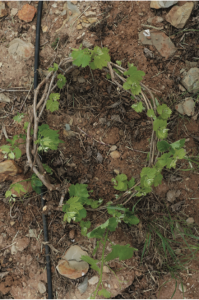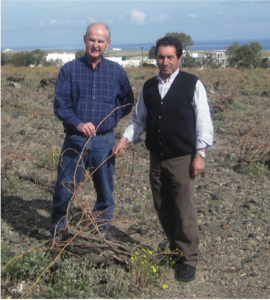By Peter Barry, Managing Director, Jim Barry Wines
First published in the March/April 2016 issue of the Wine & Viticulture Journal

I first tasted Assyrtiko in 2006 while on holiday with my wife, Sue, in Santorini, and again the following year at the London Wine Fair. Assyrtiko immediately stood out as a variety suited to the modern Australian palate. The fresh, crisp, acidic qualities of the wine are perfect accompaniments to contemporary Australian food – it is a natural partner for our climate and cuisine. Considered by wine experts as one of the greatest wine varieties in Greece, Assyrtiko is to Santorini what Riesling is to Clare, representing 70% of the island’s vineyard area. We produce several different dry Riesling wines with a pH generally around 3.00 and titratable acid of 7.0 grams per litre, and with sugar levels around three grams per litre.
After tasting the wine for a second time, I was smitten. I immediately contacted wine writer Max Allen to see if he was aware of any Assyrtiko vines in Australia. After confirming there were none, I contacted Greece’s only Master of Wine (at that time), Konstantinos Lazarakis, for a lead on obtaining cuttings I could then import to Australia. Konstantinos advised me that he had a great relationship with the top three producers of Assyrtiko in Santorini and suggested that I contact Yiannis Paraskevopoulos, at Gaia Wines. Emails between myself and Yiannis ensued, and in February 2008 we travelled to Santorini together to collect the cuttings of Assyrtiko from Yiannis Argyros, at Argyros Winery. We collected eight dormant cuttings from a single vine, thus establishing the true mother vine and our very own Santorini clone. Upon their arrival in Australia, the cuttings were placed in quarantine for a mandatory two years, and following release were propagated from the mother vines with the help of Robert Hill-Smith and the Yalumba Nursery, resulting in the production of 300 cuttings. I collected 32 buds in 2011 and grafted these onto 16 Riesling vines on two sites in Clare.
Over the next two years another 2500 Riesling vines were grafted. On 28 August 2012 we planted 1400 Assyrtiko vines (half a hectare) at our Lodge Hill Vineyard, on the eastern ranges of the Clare Valley. Lodge Hill is a unique site with two distinct soil profiles and, in essence, two vineyards comprising Riesling and Shiraz. The Shiraz vineyard’s soil consists of about 40-50 centimetres of rich, chocolaty loam over rock, consisting of almost vertical sheets. The cracks between the sheets have been filled with soil, providing passage for the vine roots and free drainage. The soil in the Riesling vineyard, on the other side of the crest, is brown loam over a layer of clay and slate bedrock that is about 600 million years old and has cracked just off the vertical so that water can drain freely through it. It’s a soil that nourishes the vines adequately, but makes them struggle just a bit, making it suited to growing intensely flavoured, finely structured Rieslings.
Our Assyrtiko was planted on a south-facing slope at the Lodge Hill vineyard, which at 480 metres is one of the highest points in the valley. Being known to adapt well to different soil types, we had anticipated that the Assyrtiko would do very well in Clare and have now planted a total of three hectares at Lodge Hill. On Santorini, Assyrtiko is grown using a unique technique known as the ‘koulara’ method, with each vine woven into a circular basket shape to protect the vines from the island’s strong winds, as well as protecting the grapes from excessive sunburn caused from exposure using typical trellising systems. We have emulated this method in Clare, with a handful of our own vines grown and pruned using this unique Santorini technique, while the rest are grown on trellises.
We picked our first parcels of fruit in 2014, producing 15 litres of wine (42 half bottles) from our first vintage. Our second vintage of Assyrtiko was picked by hand on 5 March 2015, and then whole-bunch pressed to produce 1000 litres (1341 bottles) of wine with a pH of 2.98, TA of 6.6g/L and 12.7% alcohol v/v. We are planning to plant another 9000 vines this year, with 7000 of these planted using the traditional koulara method.

Similar to the distinct flavours of our site-specific Rieslings (namely The Florita, Watervale and Lodge Hill), Assyrtiko provides a true expression of terroir, exhibiting an earthy and mineral aftertaste reminiscent of the volcanic soil of Santorini. Our soil and climate have imparted their own unique characteristics to our Assyrtiko, however, I believe we have reproduced some of the ideals of Santorini, producing a crisp and dry wine. Only a handful of people have had the chance to taste our 2014 and 2015 vintages given the small quantities produced, however, we are planning our first commercial release of the wine this year. We have been lucky enough to showcase the 2015 vintage at a promotional Greek wine tour in 2015, and more recently at Wine Australia’s Australia Day Tasting, in London. The feedback so far has been positive, with a lot of excitement surrounding the first Australian Assyrtiko. Australian wine industry consultant Dan Traucki described the wine in Wine Business Magazine as “stunning, with lovely lemon and citrus peel aromas, crisp, almost steely on the palate with great texture and a clean, crisp, lingering finish. It is an Aussie expression of this classic Greek variety with all the hallmark characteristics, but with slightly softer acidity. A sensational start for the variety in this country”.
My late father, Jim Barry, was a pioneer winemaker in Clare and was a passionate believer of keeping with the times and making wine consumers wanted to drink. In 1966, he urged those in the region to steer away from traditional varieties such as Crouchen, and to plant Riesling, Cabernet Sauvignon, Shiraz and Malbec – varieties that were uncommon in those times. While the laborious process of importation and quarantine has discouraged many growers in Australia from trying something new, I, like my father, have an interest in growing grapes that have a sustainable future in our region. Assyrtiko is predominantly grown on Santorini in arid, windy and hot conditions. Clare is a cool region with good rainfall, but we must face up to climate change and water scarcity and adapt our management appropriately. Varieties that can grow with minimal irrigation and still produce contemporary wine styles is what we all look for.
Assyrtiko

By Peter Dry, Emeritus Fellow, The Australian Wine Research Institute
Background
Assyrtiko (ah-seer-tee-KOH) is a variety unique to Greece. Synonyms include Assirtico, Assirtico and Asyrtiko. Until relatively recently, it was restricted to several islands in the Aegean Sea, and best known for its wines from the island of Santorini. In recent years has been planted on the mainland, particularly in Macedonia, Attiki and Pelopponese. The total planted area in Greece was 902 ha in 2010 of which 70% is currently on Santorini. The vineyard area on Santorini has declined substantially over the past 30 years due to reduced export demand for its wine and increased land use for tourism. Although Assyrtiko is the second most important white wine variety of Greece (after Savatiano), it only makes up 2% of the total national area.DNA analysis has revealed that Assyrtiko has a parent/offspring relationship with both Gaidouria and Platini. Also, there is no genetic link with either Spanish or Near Eastern varieties which suggests that a possible origin from those places is most unlikely. Outside of Greece, the first commercial planting was made in 2012 in the Clare Valley of South Australia by Jim Barry Wines—the first wine was available for industry assessment in 2015. Yalumba Wines crushed their first batch in 2017. There are also two very small recent plantings in California.
Viticulture
Budburst and maturity are late (it ripens 2 to 5 weeks after Merlot in Greece). Vigour and yield are moderate. Bunches are medium to large and compact with large berries. It is tolerant of downy and powdery mildews and is also said to be drought tolerant. On Santorini, old vines are traditionally trained to a basket system (kolouras) and cane pruned; however, newer vineyards (and on the mainland) are trellised.
Wine
Because Assyrtiko has the ability to retain high levels of acidity, even under hot climatic conditions, wines are fresh with a strong acid backbone and low pH. Descriptors include citrus, green apple and floral. It is prone to oxidation. On Santorini, Assyrtiko is mainly used in blends with Athiri and/or Aidani (75% or more Assyrtiko) and less commonly for single variety wines—it is usually harvested at relatively high Be for a white variety and wines of 13 to 14.5 % are very common. In Attiki and Macedonia where Assyrtiko is usually blended with Sauvignon Blanc or Semillon, wines are broader with more intense fruit character.















